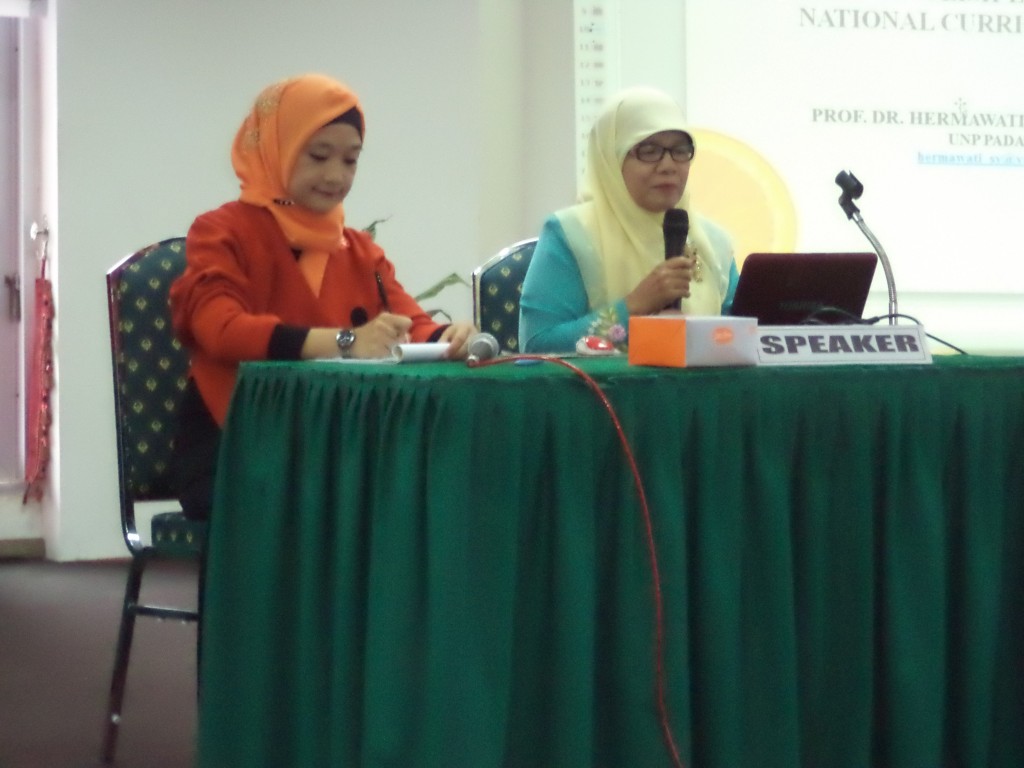Padang – On June 2013, the government started to implement curriculum 2013. This issue is being discussed in several fora where people show their different points of view. Some people support this idea, while others strongly reject it. Related to this issue, VDMS Alumni Association of West Sumatra regional held stadium general entitle “Get Ready for Curriculum 2013: Getting Smart Students through Effective Curriculum Implementation,” Friday (1/11) at Pascasarjana UNP.

Prof. Dr. Hermawati Syarif, M.Hum explained four basic elements in instructional design: materials, objectives, method and evaluation
At the beginning of stadium general, Prof. Dr. Hermawati Syarif, M.Hum, one of speakers with the title of her presentation “The English Language National Curriculum 2013” explained four basic elements in instructional design: materials, objectives, method and evaluation. It is integrated each other to run curriculum effectively.
Curriculum 2013 is a form of integrated work between reconstruction of passing grade competence, suitability and adequacy, expansion, advancement of the materials, learning revolution and evaluation reform. For English Subject, Hermawati Syarif explained materials learned are stressed on language competence as a means for communicating ideas and knowledge, learned are trained to read and comprehend the text presented, summarize, and present it with their own words.
“Learners are not trained to arrange texts systematically, logically, and effectively through continuous exercises,” she said.
On this curriculum, learners are also introduced the suitable rules of texts to avoid confusion in the process of arranging text (based on situation, condition: who, what and where). Beside that, learners are made used to expressing themselves and their knowledge using spontaneous good language.
She added the essentials of curriculum 2013 are every subject supports all competencies (attitude, skill and knowledge) where subject is designed tied one and another and it has basic competence which is tied by the core competence of each class.
“Instructional activities of all subjects have the same approach, that is scientific through observing, questioning, associating, experimenting, and networking.”
On the second session, Dr. Desmawati Radjab, M.Pd delivered her explanation to 134 participants about teaching and learning models in curriculum 2013. She emphasized on scientific approach in teaching and learning models. The teachers should understand of scientific approaches; observing, questioning, associating, experimenting and networking.
“By understanding those scientific approaches and know how to apply it in the classroom, the teachers can play their roles during teaching and learning process. Because curriculum 2013 is based on process oriented, not product oriented,” she explained.
In addition, problem based learning (PBL) is needed in order to develop meaningful learning. In PBL students integrate knowledge, skill and attitude. It develops critical thinking, initiating, internal motivation and interpersonal relation. “PBL is a kind of learning how to learn where students work in team to solve the problem and develops curiosity.”
One of participants Eka Lismaya Sari, graduate student from State University of Padang said fully satisfied by following this stadium general. At least as a English teacher later on she knows what is curriculum 2013, how to apply it in teaching and learning process especially for English subject. So far, she doesn’t know of this new curriculum because of less socialization process itself to teachers, so many teachers are still confused about this.
“Hopefully, the event likes this can be held continually in order to give information for teachers and graduate students about implementation of curriculum. To get smart students, it starts from curriculum itself and how to apply it in the classroom.” Afdal Ade Hendrayana
